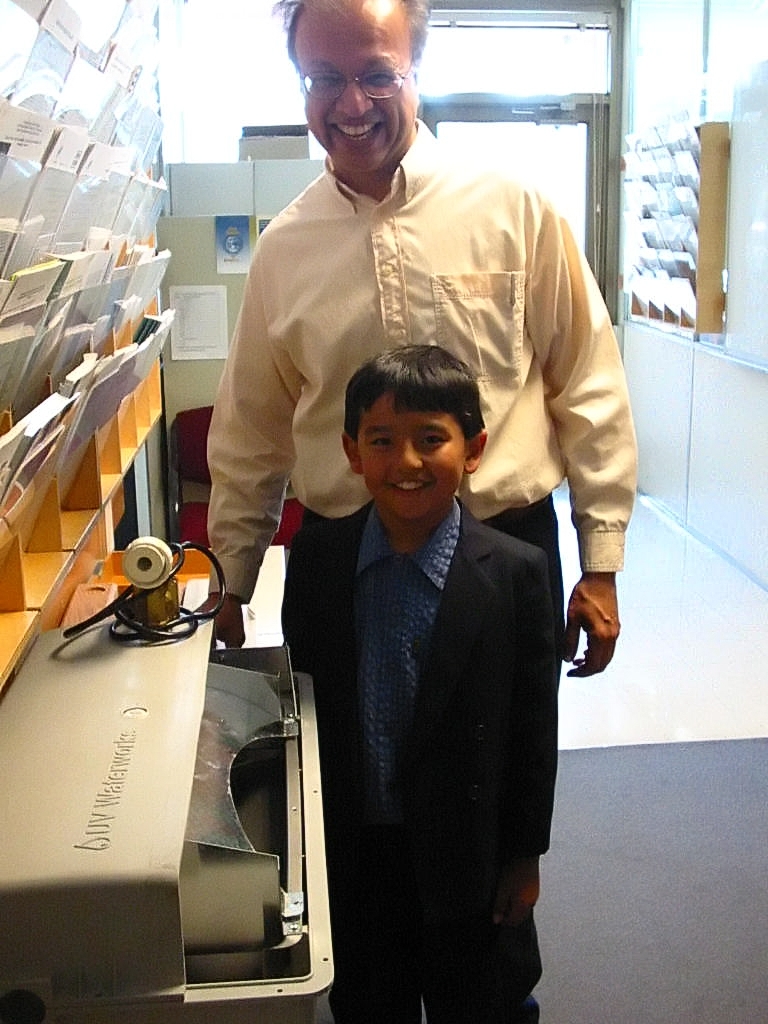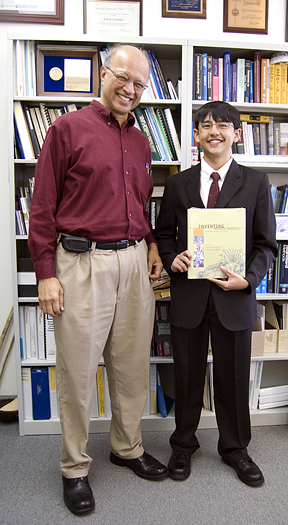Contact: Julie Chao
When Javier Fernández-Han was nine years old, he and his family met Ashok Gadgil, a senior scientist in the Environmental Energy Technologies Division who invented UV Waterworks, a simple water-purification system. At that meeting in 2003, Javier asked Gadgil to autograph a copy of his patent paper for the water purifier, which Javier had downloaded from the Internet. It turned out to be a momentous occasion for the boy.

Ashok Gadgil and Javier Fernández-Han first met in 2003 (above), when Gadgil showed the young Javier a model of his UV Waterworks. They met again Monday (right), after Javier took first place in the “Invent Your World 2009” contest.
Six years later, Javier, who is now 15 and lives in Houston, entered “Invent Your World 2009,” a contest co-sponsored by the Lemelson Foundation and AshokaTech’s Youth Venture, which called on participants to invent something “to make life easier, the planet greener and the world better.” Nearly 300 youths from 30 countries responded to the challenge. Javier, one of the youngest entrants, took first place, winning a $20,000 scholarship and a trip to a global roundtable on climate change at MIT.
His inspiration? He credits his meeting with Gadgil for motivating him to help those who live in poverty. “I’ve had that [autographed] paper in my room since then,” he says. “It’s inspired me to do good for the 90 percent of the world that lives on $1 a day.”
On Monday, Javier and his family visited Gadgil at his office to thank him and take him out to lunch. “This is extraordinary, a truly amazing story,” said Gadgil, who also serves as EETD Deputy Director. “He’s a very thoughtful guy, very creative inventor, a systems thinker.”
Javier calls his invention VERSATILE, the Village Energy Reactor Solar Algae Technology Integrated Life Enhancement system. It combines various existing technologies in a closed system to treat waste, produce methane and bio-oil as fuel, produce food for humans and livestock, sequester greenhouse gases and produce oxygen. Driving the whole system is algae, which Javier learned about when researching a biology project.
“When I was researching biofuels, I found out about algae, which can do so many things,” he said. “I thought, wouldn’t it be great to attach different things. So I kept adding different things.”
Indeed, Javier’s invention has several components. The system starts with organic waste from a latrine or from animals, which then goes into an anaerobic digester to break the material down. The wastewater goes to an algae trough while the gas produced from the digester is separated into three main components: hydrogen sulfide (which is neutralized), carbon dioxide (dissolved in water and fed to the algae bioreactors) and methane (collected). The methane is stored for fuel. The algae bioreactors produce oxygen and algae biomass, which can be used as food for livestock and people. A Play Pump (powered by children playing) produces electricity to power the biogas upgrader.
What Javier still remembers from his 2003 meeting with Gadgil was a story of Gadgil’s youth in India. As Gadgil put it: “My dad and mom had a way to always bear in mind people who happen to be victim of circumstances. They had a little earthen pot. Every day, the tradition was, I would have to put a fistful of rice in the pot.”
Gadgil still chuckles at the thought of signing an autograph for the young Javier. “Scientists in this country never ever get asked for autographs,” he said. “In other countries they do. They do in India, and I’m sure it’s like that in many countries where pursuit of knowledge is an extremely highly respected goal.”
But he believes it’s important for youth with an interest in science to start early. “The most important thing you can do as a young person is to devote your interest, creativity, ideas to think about these problems,” he said.
Javier’s parents are not scientists, but they heartily support his endeavors. It was his father, Peter Han, who arranged the meeting in 2003 after seeing Gadgil featured at the Museum of Science in Boston in an exhibit profiling five inventors who had done something useful for the world. As they stepped off the elevator for their meeting with Gadgil Monday, Han was filming every moment.
Javier himself is already thinking about the future. In an interview with an AshokaTech blogger, Javier said, “I envision my grandchildren asking me in amazement one day as we tour the Boston Museum of Science, ‘Granddad, was there really a time when the versatility of algae was not harnessed but rather algae was treated as pond-scum… a nuisance?’”
Additional information:
- Slide show of Javier’s invention http://www.scribd.com/doc/17106184/Versatility-Slide-Show-of-the-VERSATILE-System-by-Ashoka
- Javier’s website http://versatilesystem.ning.com/
